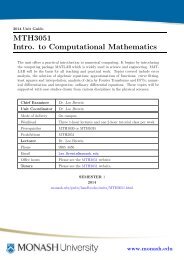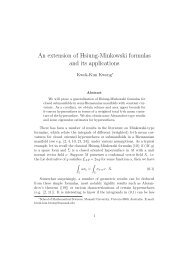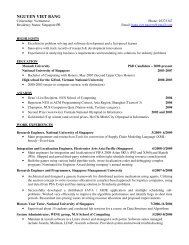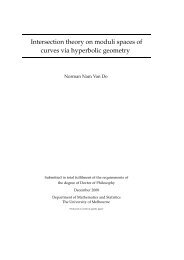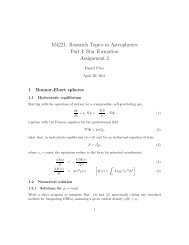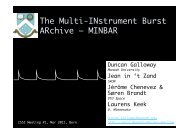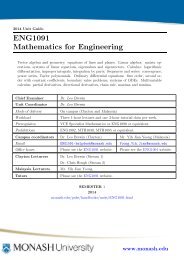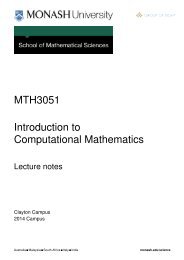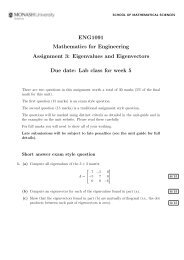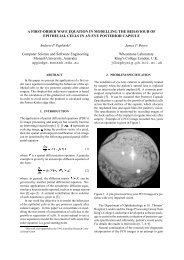Soft Matter - User Web Pages - Monash University
Soft Matter - User Web Pages - Monash University
Soft Matter - User Web Pages - Monash University
You also want an ePaper? Increase the reach of your titles
YUMPU automatically turns print PDFs into web optimized ePapers that Google loves.
<strong>Soft</strong> <strong>Matter</strong><br />
View Article Online<br />
Paper<br />
Downloaded by <strong>Monash</strong> <strong>University</strong> on 13 March 2013<br />
Published on 22 February 2013 on http://pubs.rsc.org | doi:10.1039/C3SM00016H<br />
use of exible pipette tips 11 permits drop volumes down to<br />
around 10 mL to be deposited, albeit this requires careful<br />
execution in order for them not to contact (from the tip<br />
springing back aer dispensation) the surface and thus damage<br />
the nano and micro features that endow superhydrophobicity.<br />
It should also be noted that since the liquid adheres more<br />
strongly to the pipette tip, an unknown portion of the liquid will<br />
remain within the tip, causing substantial inaccuracy in the<br />
dispensed volume.<br />
The quest to develop bioanalysis tools based on superhydrophobicity<br />
is also founded on the issues of availability and<br />
cost. Bioanalytical chemists in well endowed laboratories are<br />
oen accustomed to having a plethora of convenient consumables<br />
and sophisticated instrumentation at their disposal. Many<br />
researchers in resource-limited developing countries, or eld<br />
workers in remote locations far from modern conveniences, have<br />
been unable to take advantage of modern bioanalytical techniques<br />
due to a lack of infrastructure. This is unfortunate as it is<br />
these same researchers that usually have the greatest need for<br />
bioanalytical tools that will help diagnose diseases such as<br />
tuberculosis or malaria. Not surprisingly, there have been recent<br />
efforts expended to use alternative materials such as paper to<br />
serve as the analyte handling media. 16 This approach, while<br />
useful for methods based on electrochemical detection, is not as<br />
effective for methods that are based on optical detection, that<br />
arguably offer the highest versatility and sensitivity. Alternative<br />
cost effective approaches have since been reported. 17,18 Despite<br />
this, paper remains indispensable as a relatively cheap, compact<br />
and robust reservoir for test samples and biochemical analytes.<br />
In this work, we seek to develop a technique that will allow us<br />
to deliver drops of specic volumes on superhydrophobic<br />
surfaces from cost effective storage media such as paper so that<br />
they can in turn be harnessed to be developed into cost effective<br />
devices that permit transport. In the process, we will study the<br />
nature of how small aerosols form on these surfaces before<br />
evolving into single drops.<br />
2 Materials and methods<br />
We advance the approach depicted in Fig. 1 to circumvent this<br />
problem. A liquid supply chain was created out of a reservoir<br />
that delivers to a short capillary tube section, whose tip is placed<br />
in contact with a surface acoustic wave (SAW) nebulizer running<br />
at 30 MHz frequency using a small piece of tissue paper that<br />
constituted a capillary wick. 19 The SAW device was constructed<br />
out of a low-loss piezoelectric substrate, specically, a 127.86 <br />
Y–X-rotated single-crystal lithium niobate (LiNbO 3 ) substrate,<br />
with pairs of chromium–aluminum interdigital transducers<br />
fabricated on one side via standard UV photolithography. When<br />
an AC signal is supplied to the transducer at its resonant<br />
frequency, the SAW in the form of a Rayleigh wave propagates<br />
along the LiNbO 3 surface from the transducer at about 3900 m<br />
s 1 . Although the surface displacement amplitudes are only in<br />
the 1–10 nm range, the accelerations are extremely high (about<br />
10 7 ms 2 ) due to excitation at frequencies over 10 MHz. These<br />
huge surface accelerations are transmitted into the liquid<br />
placed on the substrate, inducing acoustic streaming. 20 When<br />
Fig. 1 Schematic description of the scheme to obtain precise volumes of drops<br />
on superhydrophobic surfaces. A surface acoustic wave nebulizer delivers a spray<br />
of aerosol droplets onto the receptacle in which the exact volume is determined<br />
using an accurate weighing scale. By covering with a superhydrophobic lid and<br />
gentle shaking, a single drop is created.<br />
the energy is sufficient (i.e., electrical power supplied in the 1–<br />
3 W range), destabilization of the liquid's free surface occurs.<br />
This leads to a breakup of capillary waves, generating a spray of<br />
aerosol droplets through a process known as SAW atomization<br />
or nebulization. 21,22 When this spray of aerosol is channeled<br />
onto a semi-spherical superhydrophobic receptacle, larger<br />
drops develop on the receptacle surface from multiple coalescence<br />
events that are inuenced by gravity (which tend to draw<br />
them towards the receptacle trough).<br />
The receptacle was fashioned out of a copper sheet (1 mm<br />
thickness), polished earlier to remove all visible scratches using<br />
silicon carbide electro-coated waterproof abrasive paper<br />
(KMCA, WET/DRY S85 P600), by an 8.5 mm radius ball indenter.<br />
Prior to use, the receptacle surface was rst cleaned using<br />
absolute ethanol, allowed to air dry, and then immersed in a<br />
24.75 mM aqueous solution of AgNO 3 for 1 minute to form the<br />
micro and nano structures. Aer this, the surface was rinsed<br />
with copious amounts of distilled water followed by absolute<br />
ethanol before being allowed to air dry. Once dried, it was<br />
immersed in a 1 mM solution of the surface modier<br />
CF 3 (CF 2 ) 7 CH 2 CH 2 SH in absolute ethanol for 5 minutes. Aer<br />
removal, it was again rinsed with copious amounts of distilled<br />
water, followed by absolute ethanol, and then air dried.<br />
For a side experiment to study the nano and microstructures<br />
forming in relation to wetting, we created coupons 20 20 mm<br />
in size out of the same copper sheet (1 mm thickness) and using<br />
the same polishing and cleaning process as previously used.<br />
The coupons were then immersed in the 24.75 mM aqueous<br />
solution of AgNO 3 for selected periods ranging from 2 seconds<br />
to 120 seconds before being removed to air dry. Aer drying, the<br />
3632 | <strong>Soft</strong> <strong>Matter</strong>, 2013, 9, 3631–3639 This journal is ª The Royal Society of Chemistry 2013



